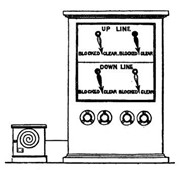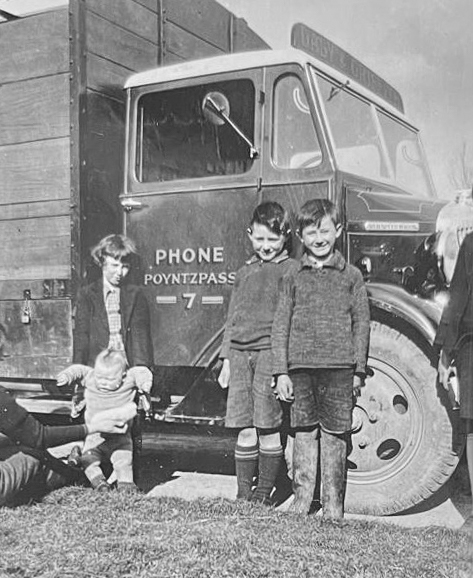Telegraphs

Electric telegraphs were introduced in the late 1830s, about 20 years before the D&BJR fully opened. This was before the widespread adoption of Morse code, and they looked and operated much like mechanical semaphore systems to spell out messages.
Only slight changes were needed to make them ideal for communicating train and track status from one signal box to the next along the line. In fact, the electromechanical displays were used in the Poyntzpass signal box right up until the time it ceased operations.
The level and gently curved trackside of a railway was the perfect place for telegraph poles and wires to be installed, to carry signals between adjacent signal boxes, such as Poyntzpass and Goraghwood. But they were also ideal for the wires needed to carry telegraph messages between the cities, towns and villages along the route.
Railway companies quickly realised this potential. The British Commercial Electro-Telegraph Company was formed in 1845, and in October that year, the Belfast Telegraph reported:
“We have learned that the Grand Junction Company are about to lay down the electric telegraph among their whole line, from Birmingham to Liverpool, Manchester and Chester. Should the London and Birmingham agree to do the same…the ordinary time for communicating news between the metropolis and the north will be reduced to a few seconds. The Telegraph is to be made available for commercial purposes, under certain restrictions.”
The term ‘telegraph pole’ was still used informally until well after the mid-1900s, to also describe poles used to carry telegraph, telephone or electricity wires. In the late 1900s, 170 years after the first railways began operating, some of the earliest high speed, high-capacity fibre-optic ‘backbone’ phone and internet cables in the UK were laid alongside railway tracks because they are often the shortest routes between two large centres of population, and the ease of installation; no tarmac to dig up and replace.
Telephones
The telephone arrived early in the region; the Newry Reporter recorded that in December 1877 Messrs. Carvill Brothers, timber merchants, had installed “telephonic communications” between their office on Merchants Quay and their various yards in Newry, only 18 months or so after Alexander Graham Bell secured his patent!
Ireland’s first public telephone exchange opened in Dublin in 1880, connecting about 80 subscribers.
One can get some impression of the growth of the telephone system from looking at telephone numbers as a proxy for the number of telephones. By 1884, adverts for Greenhill Brothers coal merchants in Belfast stated “Telephone 136”…but William Hinde coal merchants were even quicker off the mark; their phone number was Belfast 46! By 1907, new phone numbers in Newry were already four digits long; Clarke & Sons, Auctioneers was Newry 2468.
Poyntzpass Wants Telephones!
In Parliament on 19th December 1912, Dr O’Neill MP asked whether the Postmaster General had received a petition from residents of Poyntzpass to have a telephone ‘call office’ installed, and if so, what steps had been taken.
Telephones finally arrived in the village sometime in the 1920s, and the manual plugboard-type exchange was (naturally) installed in the Post Office on the square and was operated by the post office staff. The first lines installed in the village, and their phone numbers, were:
1 – The Post Office
2 – John Best
3 – M Canavan
4 – Capt. Close at Drumbanagher
5 – The new RUC station on Chapel Street (September 1929)

They must have suffered from Ghostbusters Syndrome (“Who you gonna call?”) for a few years. About the same time, the newspapers reported that additional equipment for Poyntzpass telephone exchange was ‘in hand’.
We do not know whose number Poyntzpass 6 was, but Poyntzpass 7 belonged to Felix Daly, who was a cattle dealer and transporter, as we can see from this photograph taken in about 1937. From left to right are baby Phil, Meenagh, Sean and Joe Daly.
Telephone Operators
Sharon Willsher’s mother, Ruby Henry, worked in the Post Office with Mrs Lyttle in the mid-1950s, when the exchange was still housed inside the Post Office. Subscriber Trunk Dialling (STD) was still in the future; if you wanted to make a call to someone outside the village, you had to speak to the operator and tell them the exchange and number that you wanted to be connected to. The operator wrote down the destination and duration of each call, and once a month a hand-typed bill itemising all your calls, and what each had cost, arrived in the post. All very labour-intensive and expensive.
Subscriber Trunk Dialling Arrives
But change was coming; this report is from the Frontier Sentinel, on 17th March 1956:
“It was her last ‘number please’.
At 2:00 PM on Wednesday, the Sub-Postmistress of Poyntzpass answered “Number, please” for the last time, for the manual telephone exchange closed, and the 29 subscribers [were] connected to the new automatic exchange recently installed in the village. The new equipment will provide for up to 90 subscribers and should be sufficient for the telephone users of Poyntzpass for many years to come. Post Office engineers have recently been extending the cables that will collect subscribers to the new exchange and it is hoped to meet most outstanding applicants(sic) within the next few months.”
It is interesting to note how slow the take up of phone lines was; only an additional 24 had been installed in about 30 years – less than one new line added per year in the Poyntzpass area! The great majority of homes still did not have a telephone in the mid-1950s; it was still a luxury.
The early adopters of the telephone were often those families who needed it for the family business run from the home. In those days it could take up to 18 months between applying for a new telephone line and having it installed.
The new exchange, which replaced the manual operators in the post office, was built next to the RUC station; the IRA were still regrouping prior to their late-1956 Border Campaign, and telephone exchanges were regarded as critical infrastructure that had to be protected.
STD within NI was introduced on December 5th, 1960. In 1965, questions were asked in Westminster about why it was still not possible to dial an STD call to a Republic of Ireland number; you still had to go via an operator.
Broadband
- Who got the first non-dial-up broadband connection in PP, and when? 😊